Currently sitting at 1.7 million views, the most popular youtube video of Somalia’s current president, Hassan Sheikh Mohamud (HSM), is his speech at Oxford Union:
What did he actually say in this 1 hour and 7 minute speech followed by questions and answers? The main points are summarized below – mostly in his own words and assisted by some illustrations.
Introduction
It was an honor for both the current President Hassan Sheikh Mohamud (HSM) and the OxfordUnion, when the president was set to give a speech about the issues of Somalia back in 2018. It was shortly after his presidency from 2012-2017 and before he went back into the office for a 2nd term in 2022.
“How many of you have heard about Black Hawk Down? And what about Captain Phillips?” he starts off, knowing that these two movies often comes to mind when people hear ‘Somalia’. About ½ of the audience raised their hands both times.
To the most of the world, Somalia is still unknown at large – only known through its myths and hollywood movies such as “Black Hawk Down” and “Captain Phillips”. The reality is completely different.
He describes himself as a teacher, a researcher, a civil society activist, and the president of the federal republic of Somalia.
In addition, he mentions his the “Union for peace and development party” he had established the month before.
The realities about Somalia
To contextualize the realities of Somalia, he tells a representative (although fictional) story:
There were two brothers, both living in Somalia in 1991, when the country completely collapsed after a period of instability – their names were Ali and Abdi.
Their parents took them to a remote ancestral village to avoid the civil war, which meant NO school.
21 years later (in 2012): Both are married. Both have kids. But they have 2 huge disadvantages:
1. No education → meaning 0 Chance of employment.
2. Lack of security → meaning no farming and livestock due to fear of looting.
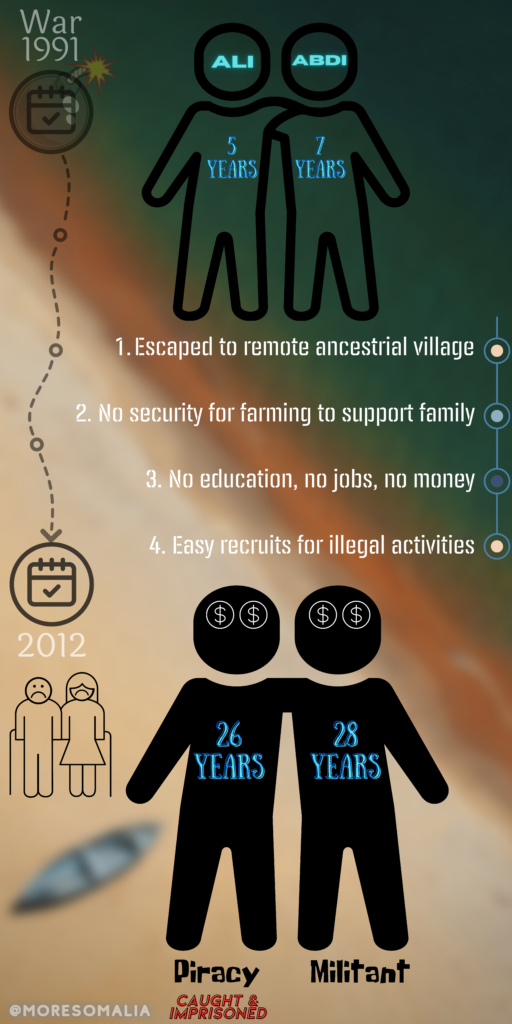
These young men still cannot take care of their family – not their kids nor their parents. They represent some of the struggles experienced by the 70% youth population of Somalia. Specifically these men are experiencing a confusing life in frustration and full of anger and instability.
Then a pirate ringleader came to recruit Ali.
He didn’t convince him to become a part of the piracy, but instead explained to him they were going to defend the national waters like missing Coast Guards and Navy of Somalia. They were going to defend the country from illegal fishing and people who drop toxic waters in the ocean. He was promised a handsome reward.
However, he got caught and was imprisoned for 10 years.
An Al-shabaab (AS) recruiter then came to recruit Abdi – the other brother.
Since the brother couldn’t be there, he was promised a compensation of 50 USD/month to join them.
With a finger pointed at the audience, HSM tells that most of the AS fighters are not there for ideological reasons, but for economical reasons or for revenge linked to clan warfare.
The old parents are now without their two sons. They get the news that a new president that isn’t transitional has been elected. A permanent/stable government, after one of the longest transitional periods any country has experienced. From their perspective, this is the first president who can build the country with full responsibility. Maybe this could help build their future?
With their glimpse of a hope for a better future for Somalia, the story ends, and he explains the situation when he got elected and what happened during his leadership.
Somalia in 2012; new president and a long to-do list
HSM was elected president after 22 years since the war broke out, without having been a politician or a minister before, and put in charge of the 1st permanent non-transitional Somali government. This was after 10 years of civil war + 12 years of transitional governments. People expected a lot. The situation was as follows:
- State revenu was 60 mio. That is 2 cents per child per year in school.
- Most Somalis believe ½ of Somalia was lost during the colonial era to neighboring countries.
- The last time Somalia had a functional public school was in 1991. The majority of the population cannot afford the private schooling.
- There are 100+ clans in Somalia, and they all want to govern the country.
- The legal code is written in Arabic and Italian, which aren’t national languages.
- No federal institutions to link the peripheries and the center. To provide the greasing to avoid the friction.
- There is a army of terrorists (AS) controlling the majority of the country.
- Most of the people under 25 have never been in school.
- There is no functioning industry where people can be employed.
- The international community tries to help behind a fence and from abroad.
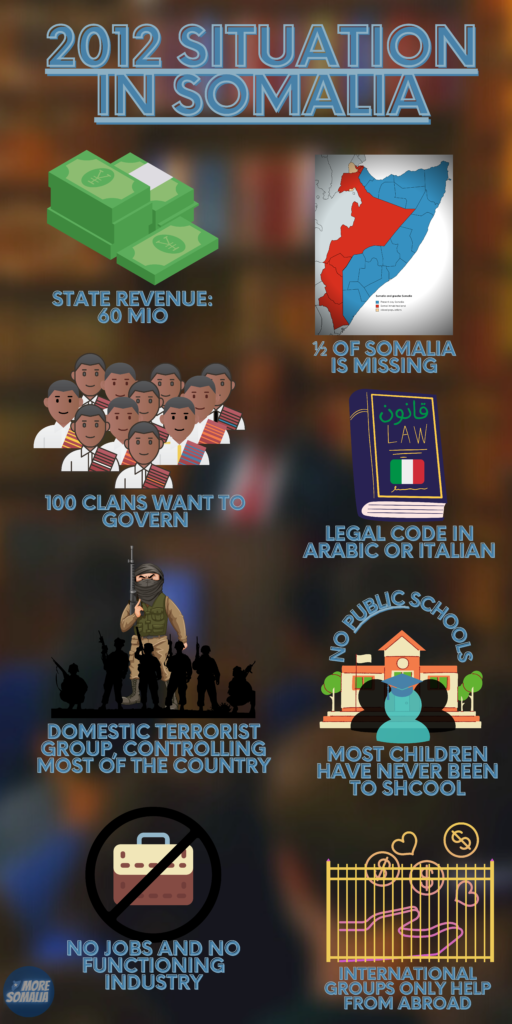
These were the main issues in 2012. As a president, what are you going to do first? He asks; there is a list of priorities, so which will be the first?
The two groups – Fears and Trust
The fears of the Somalis are divided into two.
1. The ones afraid of a predatory state, which has previously done a lot of horrible things. Here there are difficulties convincing the people, that the state is there to serve them.
2. The minor groups/clans afraid of statelessness. At the same time, they also see the major clans occupying the government positions.
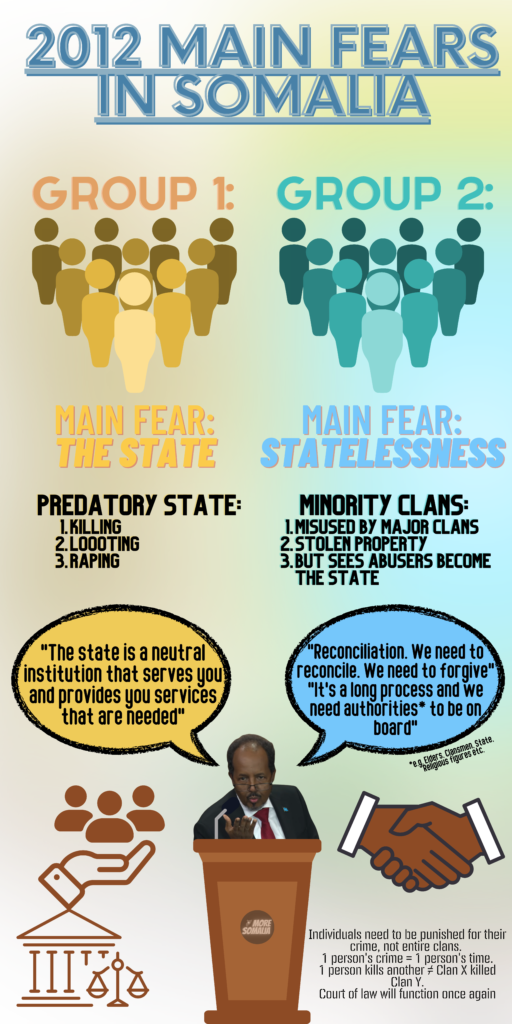
Clan warfare and revenge is a common thing. If a person from one clan kills another from another clan, they will seek revenge.
Reconciliation is key, but it is not a simple matter. You have to understand it that it is 1) a process, and 2) dependent on an authority (state, elders, religious figures) to make sure to keep the peace once reconciliation has happened.
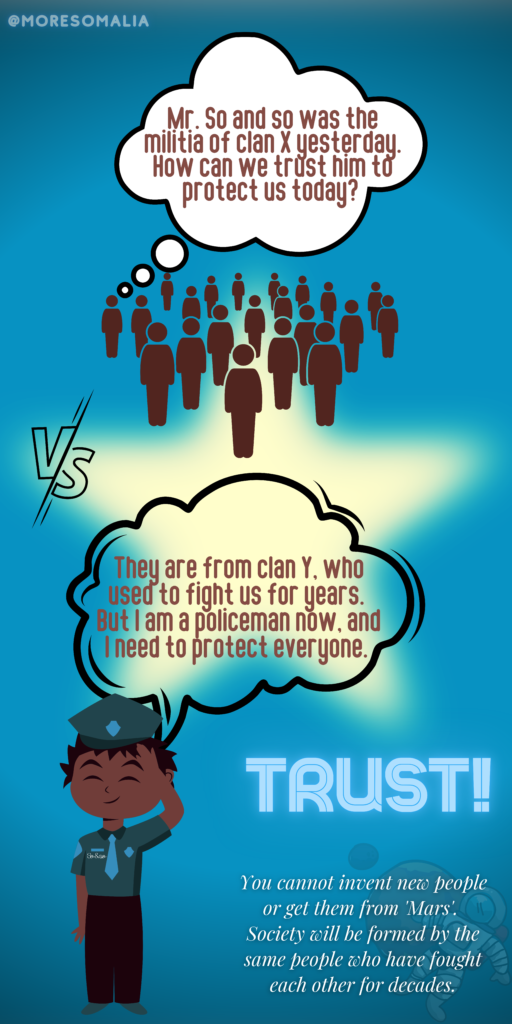
One thing missing was when he was elected was TRUST. How can you convince the people the militia from yesterday is now a policeman here to protect you today? How can you make people accept that?
And the people know Mr. ‘so and so’ was the militia of clan X from yesterday. “You don’t bring new people from Mars?” he adds.
The militia from yesterday is well known, so how can you trust he is a policeman today?
And how does the policeman convince himself, knowing his past and knowing that people know what he did, that now he is a policeman who serves and protect the people – including clan X who he has been fighting for many years.
Trust is needed from both sides. You constantly have to hold 2 these two tensions together.
This is one of the main issues in the post-conflict environment. Trust is key!
These are not only issues in Somalia, but issues for any country emerging from conflict trying to resurrect a country engrossed in conflict where both institutions and the trust of the people has been destroyed.
For HSM, there were two main questions.
1. What do we need to do to solve the problems, and
2. How do we build the foundations for the future?
How do you prioritize?
– Some want education.
– Some want clean water (to protect against diarrhea and cholera)
– Some want security (police)
Then there is AS who do not recognize the state, clans, family nor any other grouping. They believe that the only good people are the ones that agree with them. This is the thinking they are spreading in the rural areas, where they have control – not in the major cities. They prey on the people and collect protection money from minority clans (their form of tax).
HSM’s vision
HSM vision was called “Six pillars: Foundation of a new beginning”. These six pillars contained prioritization of the long list of important issues to be dealt with.
In the lead-up to forming the government, they took a look at other countries emerging from conflicts. They tried to learn from the problems of other countries and fragile states.
They learned that Somalia’s case is very unique, as there was no winner in the conflict and there were no strong partner standing with it (UK was there for Sierra Leone and France for Cambodia). For every collapsed state, none succeeded by themselves – they always had international support either bi- or multi-lateral.
For Somalia several attempts was made for this, which failed.
- The case of black hawk down was one.
- An opportunity was missed in the 1990s where the UN together with EU went to pacify Somalia. The warlords fought back, whereby the international community abandoned Somalia.
- Prior to the civil war, there was a time in the 1980s with focus on development. A time without war or conflicts. The German government made an assessment in order to support Somalia. They wanted to build an entire program and fund it with 80 million dollars. The money never reached Somalia. The 80 million stayed in Germany for 25 years (as of 2012).
The conditions for the money could not be met, since it was designed for an old structure in Somalia, and the German government refuses to update them. The money is still waiting in Germany today.
Halfway through the speech he focuses on the state and international aid.
The state
In 2013, the EU pledged 3 billion to Somalia for reconstruction and not humanitarian purposes. They came to an agreement for how it would be useful for the state. HSM’s government and EU started planning how this could be used in the state.
This is an important point, since the state is the essence of every nation, and it needs to be in control. It is like the ‘parent’ of a nation – it provides the security, funding, building, justice, centralization of all citizens and institutions etc. Thus, he spends a great deal talking about it in the next part.
He continues: How can you convince the Somali citizens that the so-called state is relevant, when the state has no budget, lacks control of some territories, and can’t provide services to them? How can you convince them they need the state?
They established the federal member states and the central government in Somalia in line with the new name of the country “Federal Republic of Somalia”. But when the trust is low, what incentives are there for the president and his government to attract the federal member states outside the capital towards the center? The president cannot help them with security or finance anyways. What attracts them to the center?
Then came the international community which reacted by saying aid shouldn’t be politicized. They wanted to provide to the people directly. The peripheral administrations have more control. When the larger international organizations wants to do/build something in Somalia they go directly to them without passing through the central government. So what is the use of the central government from their perspective?
Therefore, according to HSM: the architecture of the international aid system needs to be reviewed. These systems were developed after 2nd world war mainly for fragile countries, “but what about the post-conflict countries?” he asks.
International aid
Somalia is one of the countries that received the most amount of aid (8-12 mio USD of all that was pledged) into the government budget.
The rest of the money went to international and local NGOs, UN and other institutions who all have their own agendas. All international NGOs and multilateral insitutions, such as WHO, UN, UNICEF, FAO have a global agenda, sometimes incompatible with the local agendas of the individual countries.
The diplomats try to help the people locally without involving the leaders, but according to HSM this is not the way. This will not lead to sustainable development. The leaders are NOT rejecting the help.
“When development happens outside the framework of the state, that development is not sustainable“.
Hassan Sheikh Mohamud
Everything from the international community is build as projects. E.g. school projects.
As soon as the international community’s project ends and they leave, the people involved in the project will leave too, and the project will end. This could e.g. be the teachers, who are no longer getting paid through the projects.
Another issue is legitimacy in the eyes of the citizens and international community. When a country cannot provide certain elements and services, you are categorized as a country who has a ‘sovereign gap’.
“Now please, don’t misunderstand me. I do not mean that the international community was ill intentioned or wasn’t useful, nor provided any benefits to the Somali people. No far from it.” he reassures the audience, and continues:
- Without the support of the african union Somalia couldn’t reclaim many territories from AS.
- Without the world bank they couldn’t have the ‘financial management system reform’.
- Without the help from the international agencies they would not have he means to respond to the catastrophes such as drought, famine, flooding and other catastrophes.
- They also did support many schools.
Accomplishments
After 23 years (in 2014), he informs that they established the first public school with the aim of enrolling 3 mio students in a program called “Go2School“. The budget for this contained salaries for 1500 primary school teachers. They reopened the first public university of Somalia, Somali National University (SNU), with its 10 faculties which is giving free education to 1000s of students.
When he left the office 250,000 students went to public school for free. A great beginning indeed, supported by the international government.
The Somali government started with 60 mio in 2012, and got to almost 300 mio in 2017.
He also proudly mentions that shortly after he got to the office he saw the first budget being developed, taken to parliament, endorsed, implemented, and accounted for.
At 46 minutes he reverts to make a few more points about the international aid system.
A few more points for the international aid system
2/3 of the global aid budget can no longer be spent on post-disaster solutions rather than funding disaster mitigation to prevent disaster from occurring or be better prepared for it. This is already done in other countries with earthquakes and tsunamis.
There is a lack of flexibility, a ‘boomerang funding nature’, where northern only expertise and think-tanks along with endless bureaucracy – unsustainable characteristics in the post conflict environments of the ‘3rd world countries’.
For the international aid structure is to survive, it must be reshaped.
- Regarding Somalia, there is a few things we need to see. The international aid organizations have a global agenda and they ask ‘how do we implement this’ (their plans and agendas) rather than ‘what outcome do we need for the people?’. They do not want to ask the people what they want.
- Each country needs to be viewed through its own lens. There is no ‘one size fits all‘. Models for other countries can be useful but not replicated onto another country. There needs to be more time and resources put into understanding what is in the ground and what is missing.
- Allowing room to fail: We cannot expect to have a successful outcome for everything after 2 decades of conflict. Although he doesn’t advocate for failure, there needs to some level of tolerance. You also risk making things worse after trying to help. In addition, countries usually change over time, making predictability very difficult.
- How can we make sure resources are going to the right places?
International NGOs use local NGOs to assess and help. But the local NGOs will not return the money even if there is no need for it. They might build multiple schools near each other to use the money.
You need data
Governments cannot function without data.
In Somalia, all the records have been destroyed during the civil war except for 2 – one of which was the Somali police force whose records weren’t looted. A national data center could not be established, since the capacity was not there.
However, the international organisations had the financial and technical capacity to get whatever data they want from the locals, but it is their own data, not the government’s. These were organizations such as UNDP, DFID USaid who developed a lot of data for their missions.
So now you have a government without any data.
After a few years, HSM’s government were able to gather some data, and produce the first national plan in 2016 since the war using the new center for statistics. Unfortunately sharing of data has been an issue.
Somalia is like many other countries a resourceful country. Particularly Oil and Gas. “There was a lot of explo… seismic surveys conducted within the last 50-60 years” he corrects himself. These were done by international oil companies. They signed contracts with the previous government prior to the collapse, but now the data has been destroyed nobody know who made contracts with who, and the companies refused to give their data to the Somali government. So the government was compelled to hire their own seismic agencies to make the data and establish their own datacenter.
A final hopeful perspective
HSM says “I truly believe that Somalia has all the ideas and energy we need within ourselves” referring to the popular ‘African Ownership’ speech by Ghana’s Nana Akufu-Addo.
He proudly mentions some of the benefits Somalia has:
- Young vibrant entrepreneur population
- Longest mainalnd coastline
- Fertile soils
- Rivers
- Mineral wealth
- Strategic location
This all gives Somalia a good chance to revive and become a part of the international community.
2 questions from the audience
Almost after an hour, the audience had the chance to ask 2 questions:
1. Questions about defeating Al-shabaab.
He explains that you cannot defeat them by conventional war. They have tried reconciliation without success. You can reduce them in numbers and push them away but eliminating them takes an ‘out of the box’ thinking.
2. Is federalism the best direction and a solution for the problems in Somalia?
This is a critical question about the concept of federalism, which was established in 2004 and implemented in 2012, and which some people disagree with.
He argues that Somalis have agreed for the country to be federated. In addition: Geographically when you talk about a region in Somalia, you are talking about a clan indirectly. Before he came to office, the constitution of Somalia from 2012 established states: “Based on a voluntary decision, two or more regions may merge to form a Federal Member State” (Article 49, 6). They are still weak, and need a lot of support, but according to HSM this is the way forward. Somalia is a relatively large country (over 637.000 square km), and it needs the federal states to govern the areas far away from the capital with different people responsible for different regions. Without federalism, you create a divisive environment where the country and people might divide themselves.
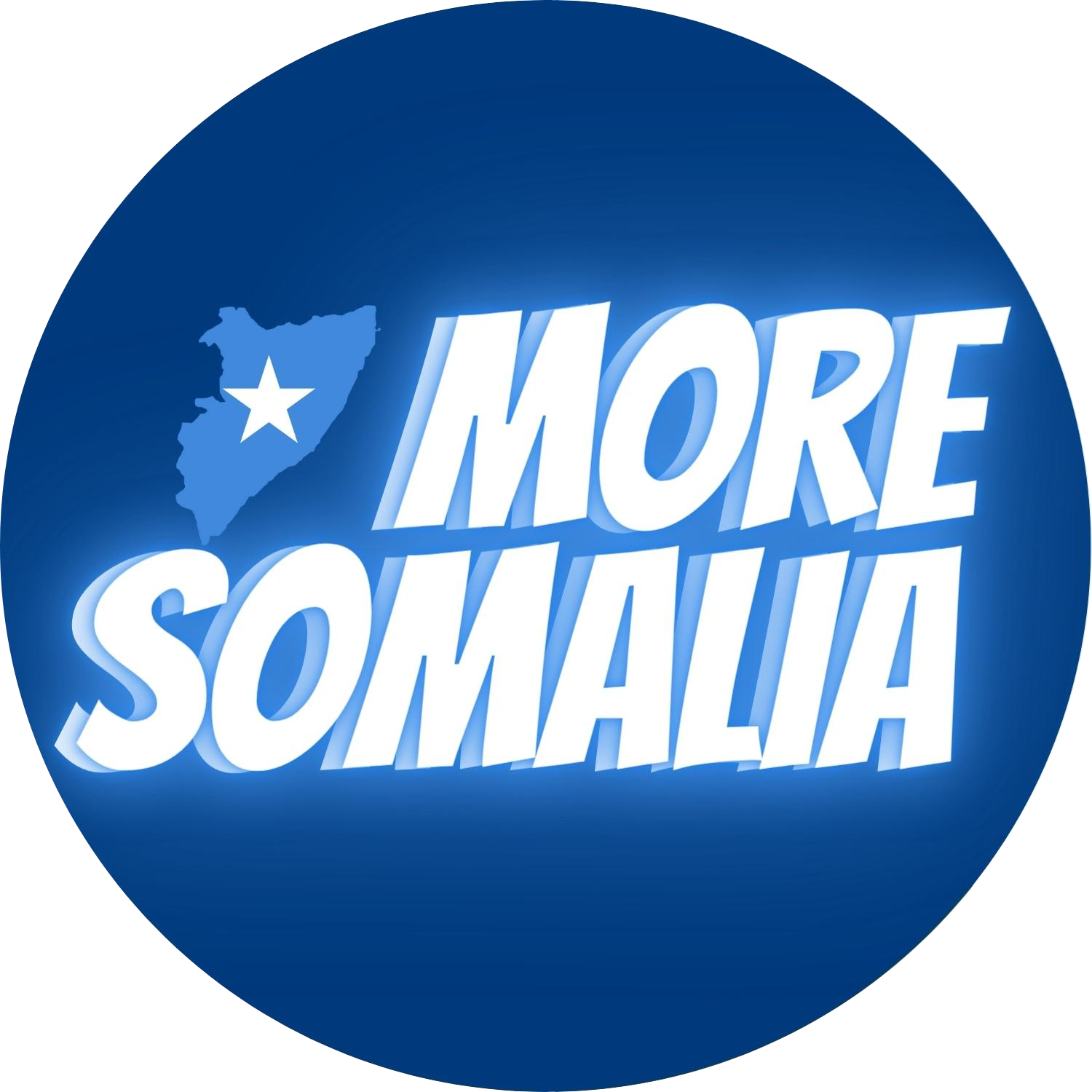
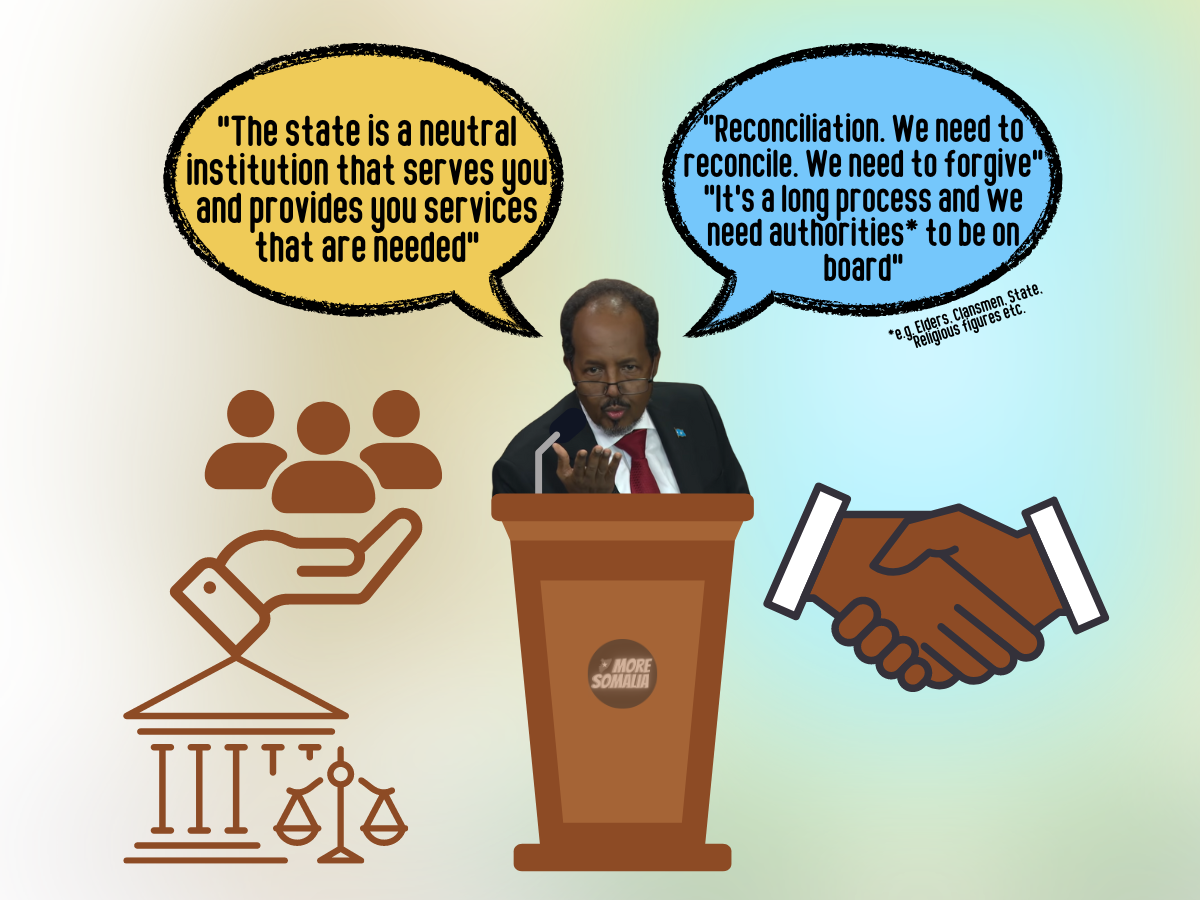
[…] asked about whether federalism is the path forward President Hassan Mahmoud Sheikh argued that without it we risk dividing the country further. This makes sense, as Somalia is relatively […]